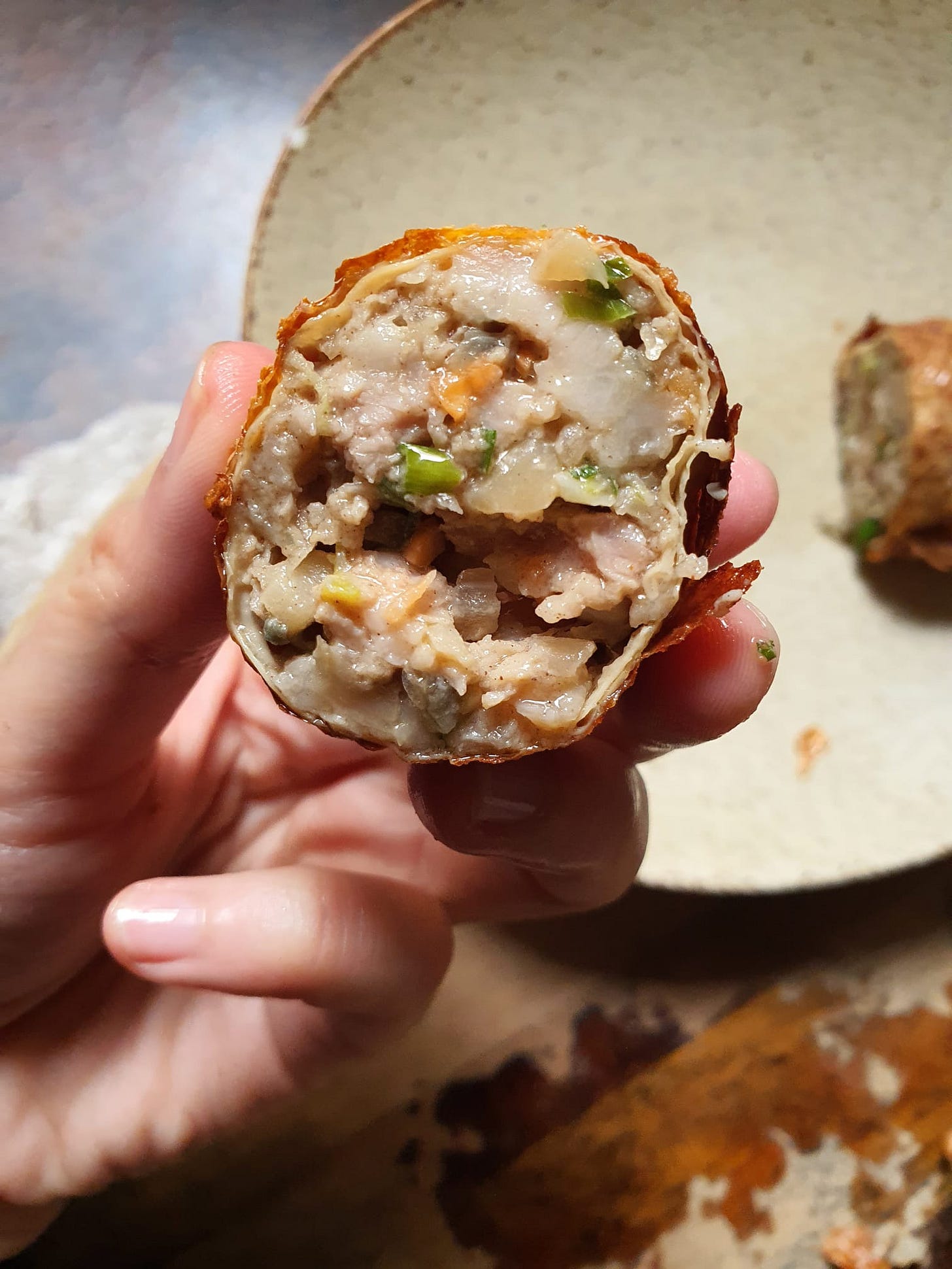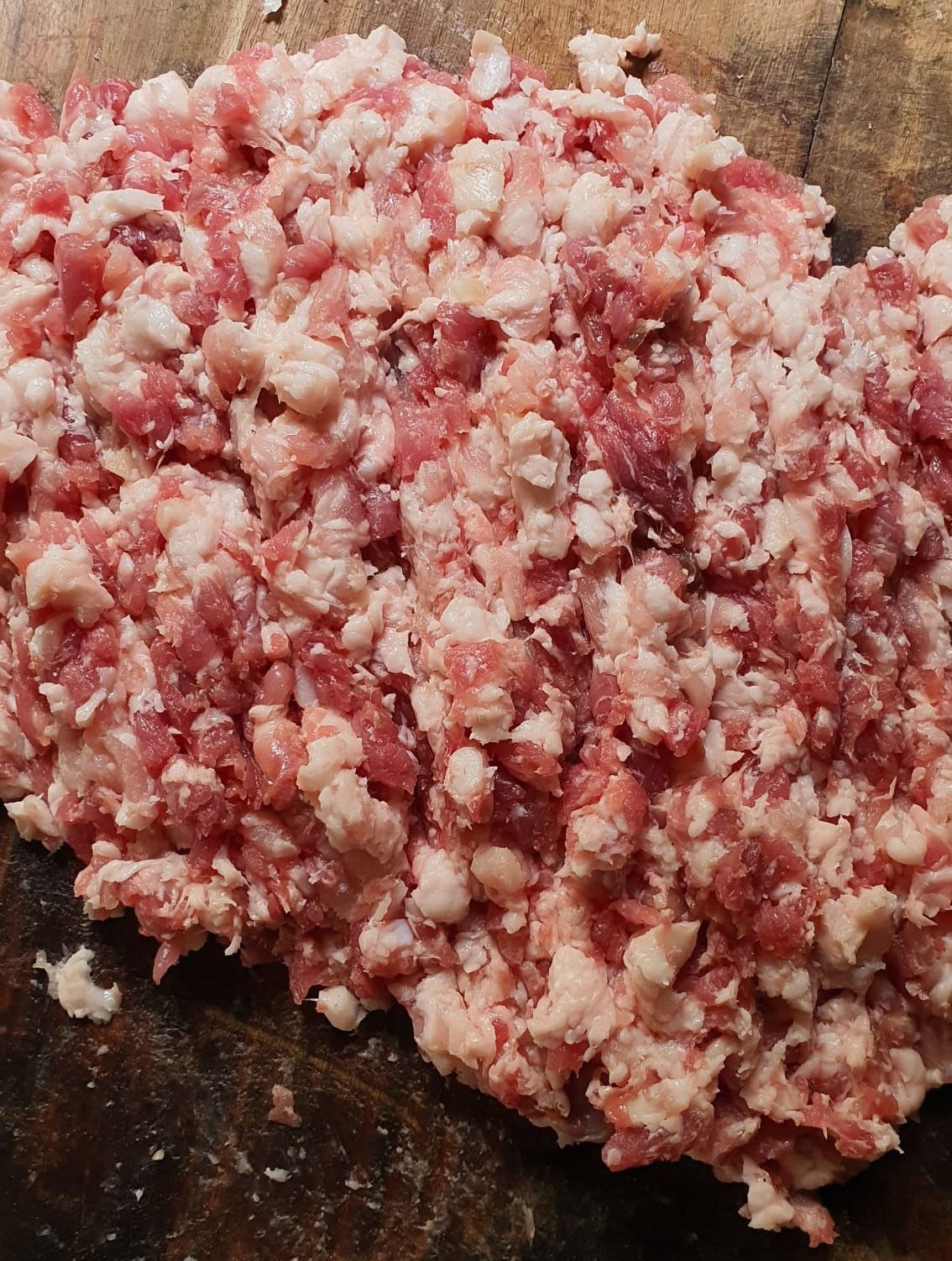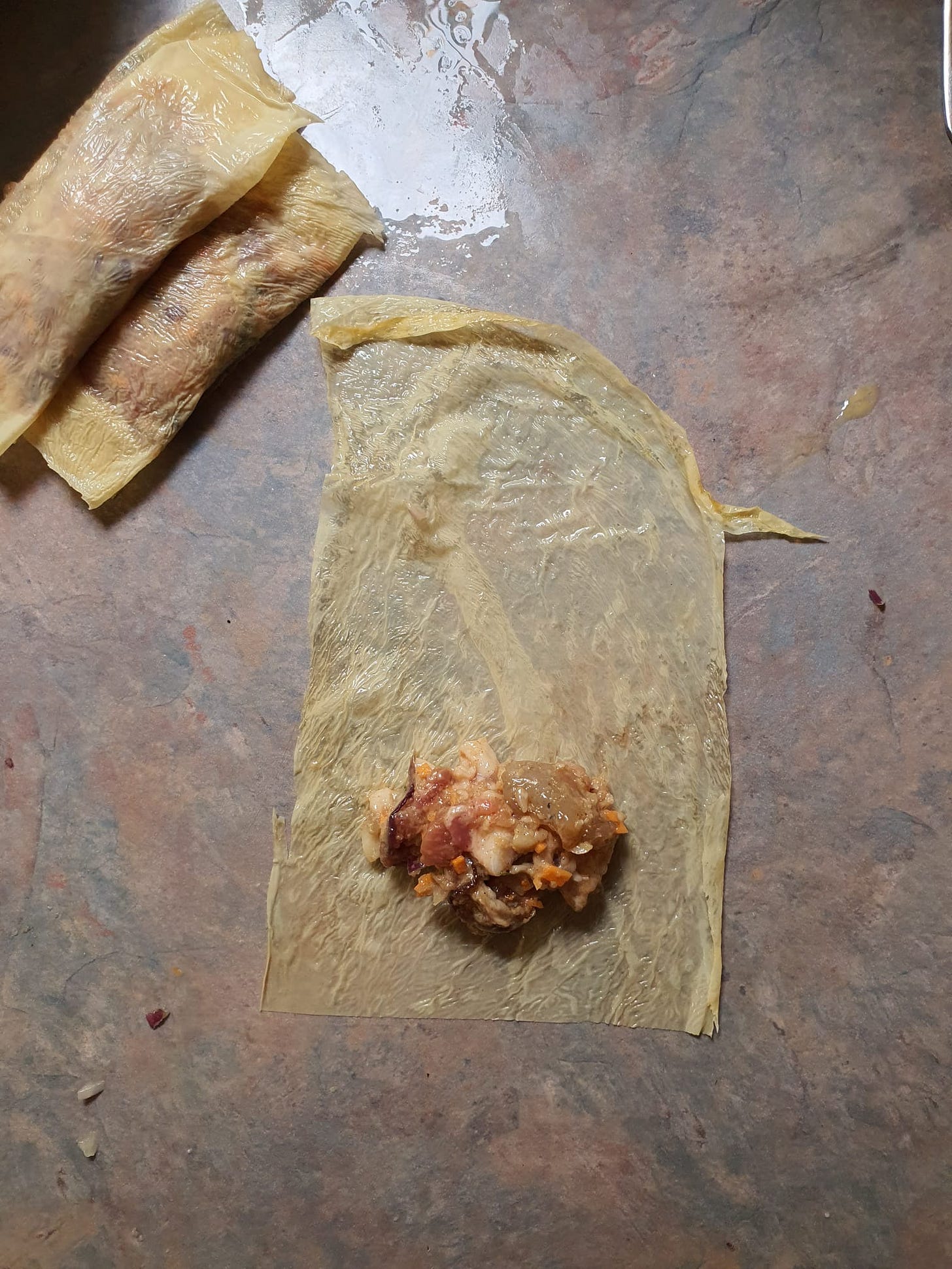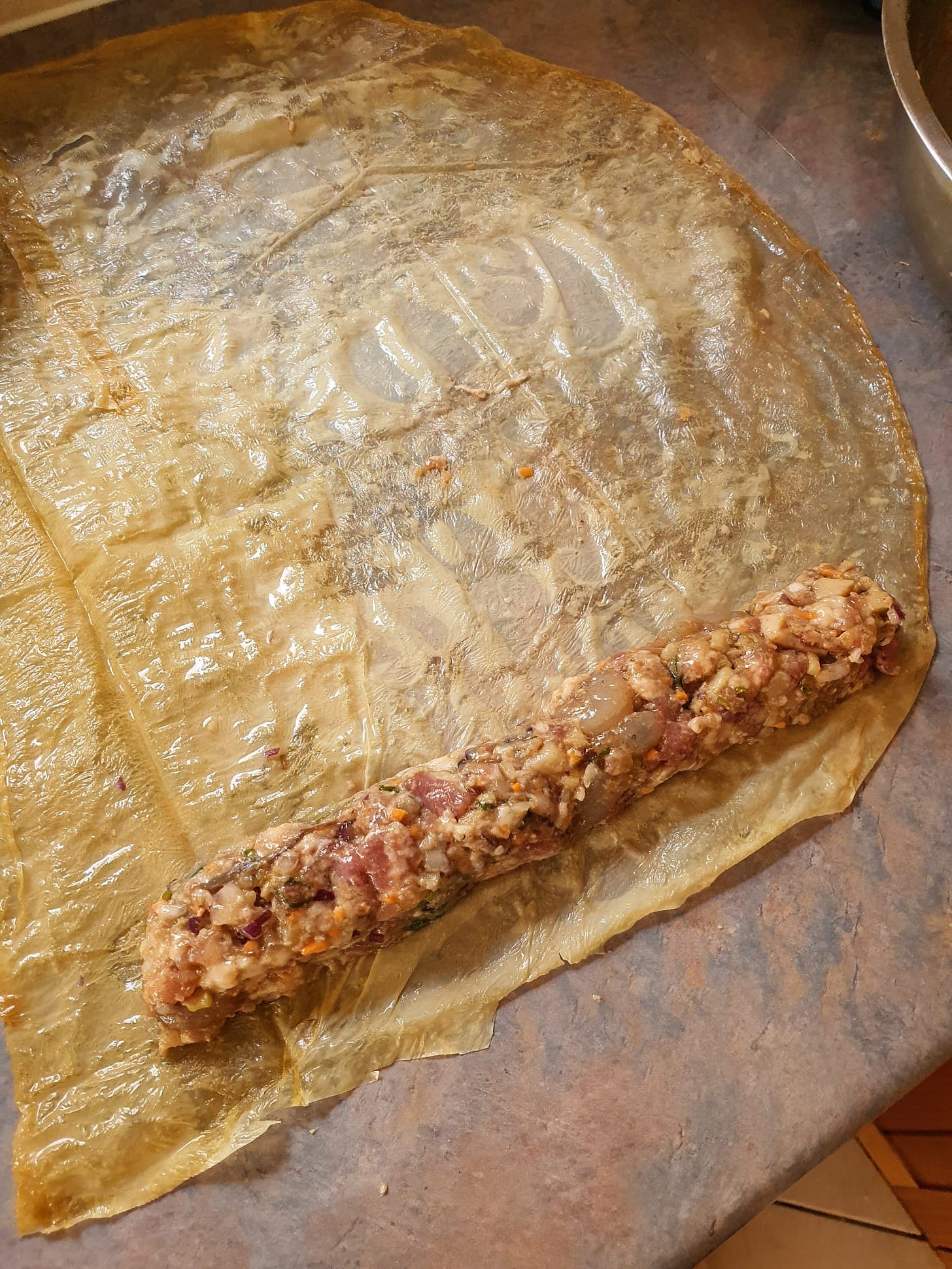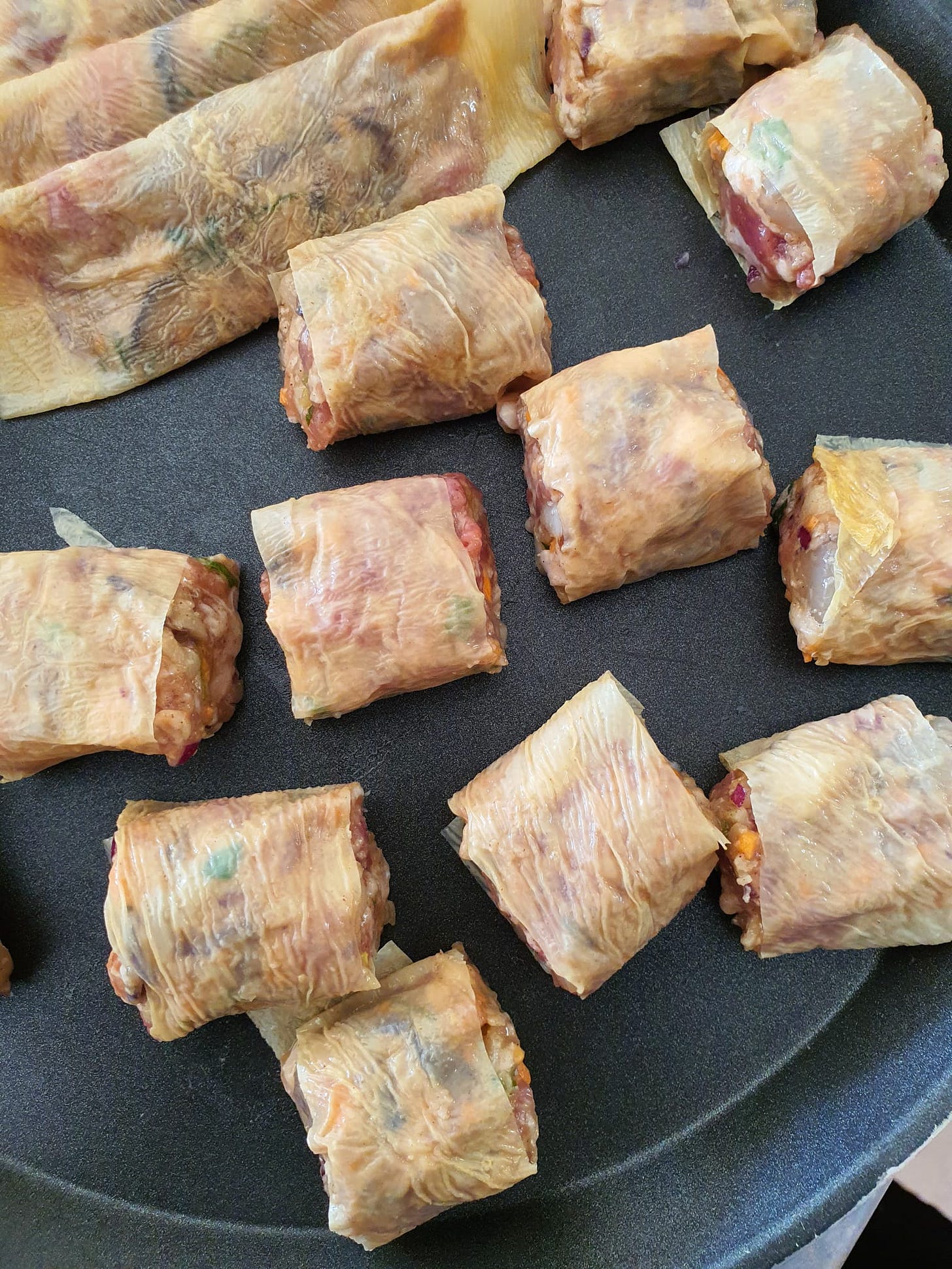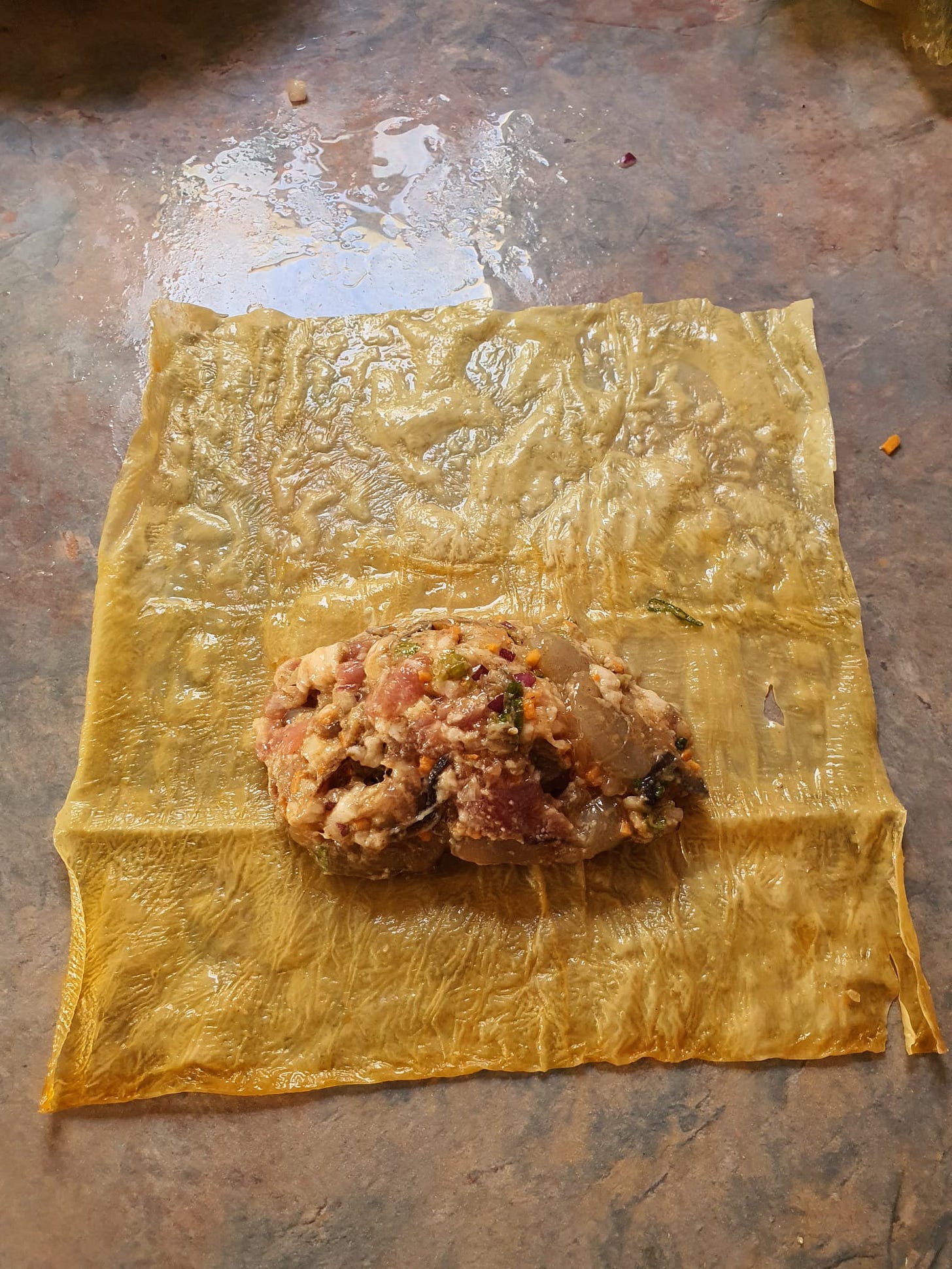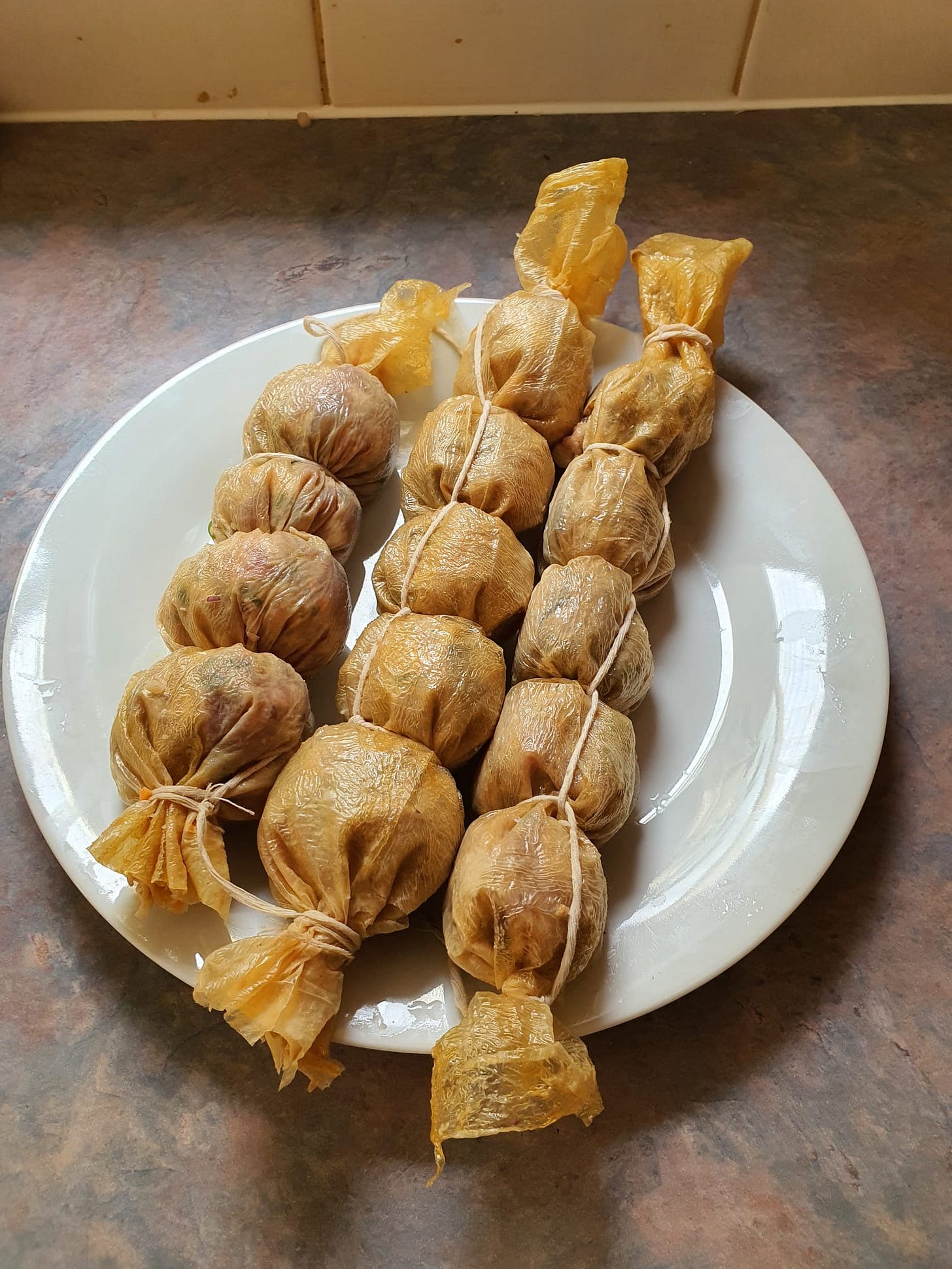I’ll be shameless and say it right here: these are the best ngoh hiong I’ve ever had.
When Wex tasted this, he said that they are even better than his mom’s, which is saying a lot, because he is a Hokkien boy whose mom makes ngoh hiong for Chinese new year every year… and she learnt it from his grandma, who is a formidable cook. Ngoh hiong is also a must-order item whenever his family eats at Chao Shan Cuisine, which means his standards for ngoh hiong are incredibly high.
I, on the other hand, was introduced to ngoh hiong late in life. It simply wasn’t part of my Cantonese mom’s repertoire. My dad’s Hokkien, but he and his family are anomalies because they are incredibly health-conscious and shun deep-fried food. So, my first encounter with ngoh hiong came when I was working at Candlenut, a Peranakan restaurant. I remember the sous chef asking me incredulously, “You’ve never had ngoh hiong before?” (I might have, at that point, but they were probably very mediocre versions that didn’t leave an impression.)
During service, the cooks referred to ngoh hiong as “sausage”, which is quite an apt description of what it is. For the uninitiated, ngoh hiong is a dumpling wrapped in tofu skin, instead of the usual flour-based wrappers. Generally speaking, it’s shaped as a long log, deep-fried, then sliced into bite-sized pieces to facilitate eating. Unlike other Chinese dumplings, ngoh hiong filling is surprisingly similar to a Western meatball. Pork mince, egg, flour or breadcrumbs, chopped onion.
I was curious if there was some kind of colonial link, but there is none. The dish originates from the Hokkien and Teochew communities in China, in a time where there was widespread poverty. In an act of frugality, people would chop up leftover bits of pork and marinate it with five-spice powder, before wrapping in tofu skin for frying.
The five-spice powder 五香粉 became the dumpling’s trademark, and earned it its name (ngoh hiong 五香). Ngoh hiong became so popular and so auspicious-sounding that it sparked a new year tradition, symbolising people’s hopes for the ‘five blessings’ (五福临门) - longevity, wealth, prosperity in career, health, and fertility.
Pork
These days, most of the ngoh hiong you get in Singapore uses minced pork, and for the longest time, that was my understanding of the dish. However, my father-in-law, knowing my interest in traditional foods, has been telling me that ngoh hiong is best when you eschew the mince and take time to cut the meat into small cubes by hand. It has more chew, he told me.
The Penangite version of ngoh hiong, called lor bak, is similar in that regard. It uses long strips of pork instead of mince, and serves the sausages with lor sauce (thickened soy braising liquid), tangy chilli sauce, cucumber and taukwa (firm tofu).
I originally wanted to get coarse ground pork belly from the butcher’s out of laziness, but decided against it when the butcher was closed by the time I got to it. So, I bought a couple of pork belly strips from the supermarket, diced it finely, then ran my cleaver through once so that the meat was barely minced.
Prawns
Prawns are now a common ingredient in ngoh hiong, but it didn’t use to be. After all, ngoh hiong used to be a peasant dish. Prawns, however, add crunch to the filling and I recommend adding it. I like to soak my prawns briefly in saltwater, something I learnt from wonton-making; this quick brine makes the prawns extra crunchy and succulent.
At this point, I should also bring up hei cho 虾枣, a cousin to the ngoh hiong, as there is often a lot of confusion about it. Hei cho literally means ‘prawn date’ - it must have prawns rather than pork as its primary ingredient, and it should be shaped like a date. Five spice powder is not essential to hei cho.
Seasonings and aromatics
I am aware that some, especially within the Peranakan community, make their ngoh hiong without five-spice powder. However, I believe that ngoh hiong has to have ngoh hiong. It’s what truly sets it apart from any other dumpling out there. I like my ngoh hiong robust with the flavours of five-spice powder, soy sauce, oyster sauce, and sesame oil. A little sugar also heightens the natural sweetness of the pork.
Another ingredient that I add to my ngoh hiong is fried onions - its caramelised flavour adds a little more oomph to the filling.
Binders
Singaporean recipes for ngoh hiong use a range of binders, ranging from crushed cream crackers and breadcrumbs to cornflour and plain flour. Cream crackers might sound wacky, but it was an ingredient many Chinese families used to have at home. Jacobs cream crackers in its green tin was always a mainstay at my grandparents’ place and a favourite after-school snack of mine.
In Teochew ngoh hiong, mashed taro is folded into the sausage, lending it a subtle sweetness. Taro is a very important ingredient to the Teochews because of its auspicious connotations - the Teochews believe 吃芋有头路, meaning that if you eat taro, you’ll never starve and always have opportunities. Taro also happens to be the perfect partner for five spice powder!
My mother-in-law uses crushed cream crackers and cornflour, and I took her lead. I don’t have cream crackers at home, so I blitzed up some panko finely for a similar effect.
Wrapper
As mentioned above, the wrapper of this dumpling is dried yuba (dried tofu skin). In Singapore, I hear that this can be very salty, so cooks wipe it with a damp cloth and intentionally lower the amount of salt in the filling. In Melbourne, I have access to tofu skin made with no salt at all, so it is not something that I worry about.
I have also heard of people making ngoh hiong with caul fat instead of tofu skin, pan-frying the sausage with an egg dip. I’ve tried making it this way, and find myself preferring ngoh hiong made with tofu skin because of its beany fragrance and frilly edges when fried.
Wrapping
There are several ways you can wrap your dumplings:
1. For maximum crispiness and extra frilly edges: This is for all you tofu skin lovers! Cut tofu skin into small rectangular strips, about 10cm wide. Wet the tofu skin liberally and place a tablespoon of filling on one end. Flatten the filling slightly and roll up to form a parcel.
2. To wrap a lot, very quickly: This method was originally introduced to me by Qin Yi, whose grandma makes it this way. Place a long log of filling on one end of a large, dampened tofu sheet. Roll up just a few times to conceal the filling, then cut off any excess. With a knife, cut the roll into individual portions.
3. For the prettiest presentation: Place 120g of the filling in the center of a dampened piece of tofu skin. Bring in the left and right sides and roll up like a spring roll. Because this produces a thick sausage, you will have to steam it first before deep-frying. This was the style of ngoh hiong I learnt at Candlenut. When steamed, deep-fried and sliced with a serrated knife, you get a beautiful cross-section (see the very first picture at the top of this letter).
4. For easy storage: This is my (grand)mother-in-law’s method, and what I also find the most technically challenging. It is just like tying a roast in the West, but you are working with tofu skin that is very fragile. Pull too hard and the skin breaks, not pull hard enough and you don’t get a defined waist. Getting every lump even is also a challenge. The key is to NOT dampen the tofu skin and use raffia string (kitchen twine breaks tofu skin more easily). Steam, then cut the baby sausages off at the links before storing in the freezer or deep-frying.
I’ll be putting up videos on how to wrap with these four methods on Instagram, so you can check that out if the text is difficult to follow.
My father-in-law was right: cutting the pork by hand made such a difference in texture. It was juicy, succulent, and had great bite. If you look at the first photo in this letter, you can see the tiny chunks of juicy meat. It definitely wasn’t pastey, dense, or dry like so many ngoh hiong I’ve had in the past. It was a wonderful combination of fresh, fragrant, crunchy, crisp, juicy, tender… definitely a case of something being better than the sum of its parts!
Researching and cooking this dish has been eye-opening for me and this is definitely one of my proudest recipes. Makes me wish I was in Singapore to share the results with my family and friends. I hope you’ll like it too, and happy chap goh meh/ 元宵节!
Ngoh hiong
2 tbsp salt
500g water
350g peeled prawns, each cut into 3-5 pieces depending on size, deveined




